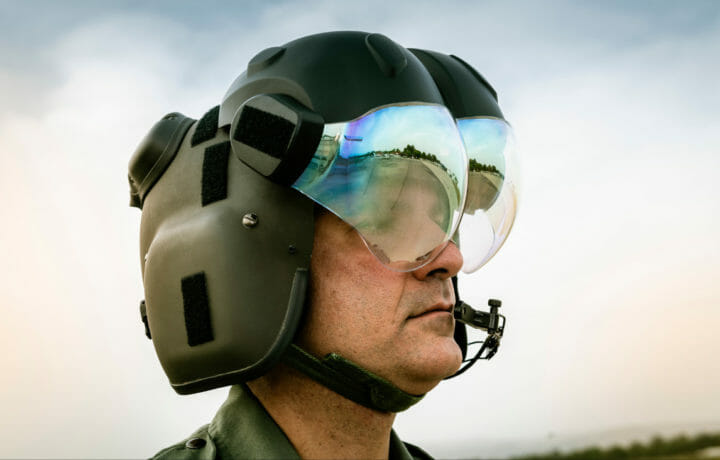There are likely many times that combat pilots wished they’d have eyes in the back of their heads, and Elbit’s X-Sight might be the very next best thing. The U.S Army tested the platform, which provides data from multiple sources to create a common operational picture on the helmet’s visor, at Fort Campbell, KY last summer.
What is also notable is that while the system was employed with a pilot on an Apache AH-64 helicopter, the visuals were also relayed to the Army Aviation Center of Excellence at Fort Bucker, AL. The Israeli-based company is now in discussions with Boeing and the Army to develop a final version that could replace the monocle display helmets currently used by Apache pilots.
The system was made for pilots by pilots, Aviel Yahav, head of business development and marketing at Elbit Systems, said in an interview this month with The Jerusalem Post.
More Than A Helmet
The X-Sight is much more than an advanced optical viewfinder. It incorporates a sophisticated sensor array, an artificial intelligence-powered mission computer, and an Augmented Reality (AR) helmet-mounted display (HMD) system. This enables real-data fusion and machine learning of obstacles and threats facing the aircraft, as well as the status of its various systems.
The HMD provides detailed radar, along with a day camera and Infra-Red cameras with thermal vision. Pilots can be provided with terrain grid with data points overlaid on real-world images with a dual-eye 61×30 degree view – greatly expanded from the current 40×30 degree view provided with the monocle display – while the visor-projected display is in full color and high resolution. Most impressively, the HMD even allows the pilot to “see through” the body of the aircraft.
The platform continuously tracks the landscape to warn pilots of potential obstacles that could include power lines, antennas, and other interferences without prior mapping. This can allow for low-altitude flight even in zero visibility. Much of this technology was actually developed by Elbit Systems for the Israeli Air Force’s F-35I “Adir” (Hebrew for “Mighty One”), the unique variation of the Lockheed Martin F-35 Lightning II fifth-generation stealth fighter.
“This technology that we developed is bringing the fifth-generation capability from the F-35 to the helicopter fleet … allowing pilots to fly in any degraded visual environment and turning this degraded visual environment from a limitation to an operational benefit,” Yahav explained.
Military Adopting Augmented Reality
The helmet-mounted display has been in development for a decade, but it is just one of the potential applications of AR in military hardware. Unlike virtual reality (VR), which is an entirely simulated environment, AR allows the overlay of digital images on the physical world.
It has already found use via smartphones in such commercial applications as the video game Pokémon Go. The military could take AR’s capabilities significantly further.
“AR is particularly useful for applications where you need to blend virtual information with a visual image without the lag or performance requirements of pre-rendering the entire image,” explained technology industry analyst Rob Enderle of the Enderle Group.
“In military use, it can be used to highlight things that otherwise might be missed like a potential bird or weapons strike on the aircraft, threats, mission waypoint routing, delineating friendly and hostile targets, and identifying the best options for an mergency landing,” Enderle told ClearanceJobs.
Especially Suited For Pilots
Elbit’s X-Sight also highlights how AR could be especially well-suited for pilots, who often face an overflow of information. Instead of having to monitor various displays and panels, much of the information can be sent directly to the visor.
It could also allow for flight operations in conditions that would normally ground the aircraft, but could also help pilots return safely if conditions changed unexpectedly.
“It can be used to show the pilot the ideal approach for landing and might be particularly useful when weather or conditions make the landing more difficult like when approaching an aircraft carrier,” said Enderle.
“In addition, it can display critical data to the pilot without forcing them to look down at the gauges and it is potentially a more reliable and less expensive way to provide heads-up displays because you can more easily mitigate things like glare which can render heads up displays much harder to see and use,” Enderle continued. “Finally, if repairs are required or instructions to a pilot who may be inexperienced with a new aircraft the technology can be used to direct the user to the area to be repaired as well as provide detailed guidance on how to execute the repair or use in cockpit controls properly. From training to operation of the aircraft the technology potentially increases the operational efficiency and effectiveness of the pilot allowing them to use the experience of others to extend their own capabilities as needs escalate during a battle or critical equipment failure.”




